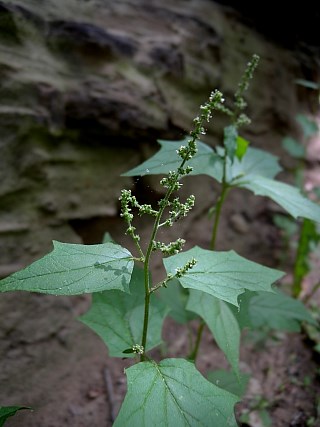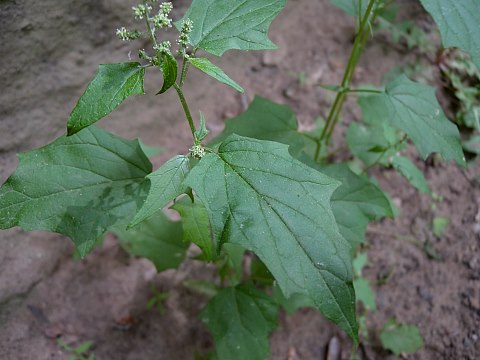Description:
This
annual plant is about ½–4' tall. Medium to large plants (greater
than 1½' tall) branch occasionally, while small plants (less than 1½'
tall) are often unbranched. The central and lateral stems are hairless.
Alternate leaves are up to 6" long and 4" across; they are ovate or
deltoid-ovate with 2-4 large teeth along their margins. These teeth are
pointed and widely spaced. The uppermost leaves are more narrow and may have only 0-1
teeth along their margins. The widely spreading leaves are medium to
dark green and hairless; they are not white-mealy on their undersides.
The leaf tips are pointed, while their bases are truncate or slightly
indented. The slender petioles are up to 1" long. The central stem and
upper lateral stems terminate in panicles of sessile clustered flowers.
In addition to these, there are usually secondary panicles that develop
from the axils of the upper leaves. The branches of these panicles can
be hairless or conspicuously hairy. Individual flowers are green or
greenish white and only 1/8" (3 mm.) across, consisting of 5 sepals, 5
stamens,
and a flattened ovary with a pair of tiny styles at its apex. There are
no petals. The sepals are ovate and slightly keeled. The blooming
period can occur from late spring into the fall. On an individual plant
in bloom, the flowers are at different stages of development.
Pollination is by wind. The persistent sepals only partially cover the
developing seeds; there is only one seed per flower. Each seed is
covered with a thin membrane that is easily removed. Individual seeds
are flattened, circular in circumference, and shiny black; they are
1.5–2.0 mm. across. The root system consists of a taproot. This plant
spreads into new areas by reseeding itself.
narrow and may have only 0-1
teeth along their margins. The widely spreading leaves are medium to
dark green and hairless; they are not white-mealy on their undersides.
The leaf tips are pointed, while their bases are truncate or slightly
indented. The slender petioles are up to 1" long. The central stem and
upper lateral stems terminate in panicles of sessile clustered flowers.
In addition to these, there are usually secondary panicles that develop
from the axils of the upper leaves. The branches of these panicles can
be hairless or conspicuously hairy. Individual flowers are green or
greenish white and only 1/8" (3 mm.) across, consisting of 5 sepals, 5
stamens,
and a flattened ovary with a pair of tiny styles at its apex. There are
no petals. The sepals are ovate and slightly keeled. The blooming
period can occur from late spring into the fall. On an individual plant
in bloom, the flowers are at different stages of development.
Pollination is by wind. The persistent sepals only partially cover the
developing seeds; there is only one seed per flower. Each seed is
covered with a thin membrane that is easily removed. Individual seeds
are flattened, circular in circumference, and shiny black; they are
1.5–2.0 mm. across. The root system consists of a taproot. This plant
spreads into new areas by reseeding itself.
Cultivation:
The preference is dappled sunlight to medium shade and mesic to dry
conditions. While this plant is usually found on rocky ground, it will
adapt to ordinary garden soil. Depending on the fertility of the soil
and moisture conditions, the size of individual plants can vary
considerably.
Range & Habitat:
Maple-Leaved Goosefoot is uncommon to occasional in most areas of
Illinois, except in the east-central section of the state, where it is
rare or absent (see Distribution
Map). This is a native plant. Habitats include rocky upland
woodlands, shaded or
semi-shaded ledges of cliffs, bottoms of thinly wooded bluffs, recently
logged or burned woodlands, woodland openings, shaded to semi-shaded
areas of rocky glades, thickets, and fence rows. Maple-Leaved Goosefoot
is often found in high quality habitats, but it also occurs in
disturbed areas. This is one of the less weedy Chenopodium spp.
Faunal Associations:
Little is known about floral-faunal relationships for this unusual
woodland plant, although several moths, skippers, and leaf beetles are
known to feed on Chenopodium spp. primarily in
weedy open areas. The Bobwhite and several sparrows eat the seeds of
these species, while White-Tailed Deer occasionally browse on the
foliage.

Photographic
Location:
Ledge of a sandstone cliff at the Portland Arch in west-central Indiana.
Comments:
Maple-Leaved Goosefoot (Chenopodium
simplex) has very distinctive leaves, which makes it is
easy to recognize. These leaves are usually larger in size than those
of many other Chenopodium spp., and they usually
have 1-4 pairs of widely spaced large teeth. Other Chenopodium
spp. have leaves with smaller teeth or their leaves lack
teeth altogether. Unlike Maple-Leaved Goosefoot, these latter species
often have white-mealy leaf undersides, white-mealy upper stems, and/or
white-mealy sepals. They are usually found in sunny disturbed areas
rather than woodlands. The American species, Maple-Leaved Goosefoot (Chenopodium simplex),
closely resembles a European
species with the same common name, Chenopodium hybridum (Maple-Leaved
Goosefoot), but it has a different number of chromosomes. The American
species is sometimes referred to as Chenopodium gigantospermum,
which refers to its relatively large seeds for species in this genus.